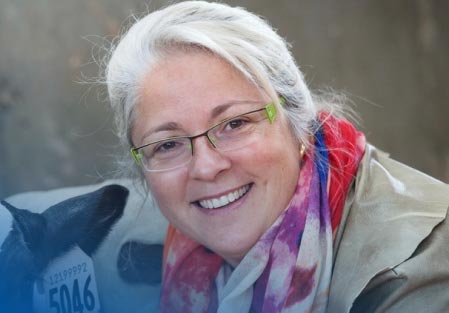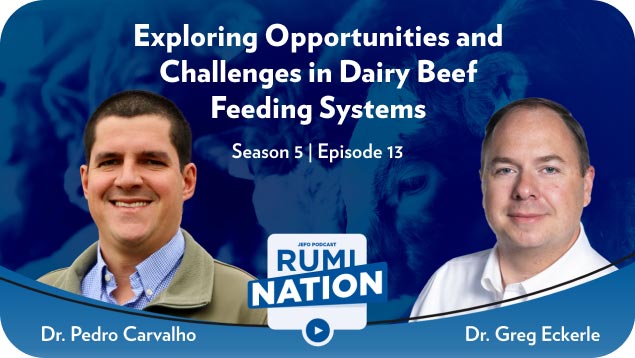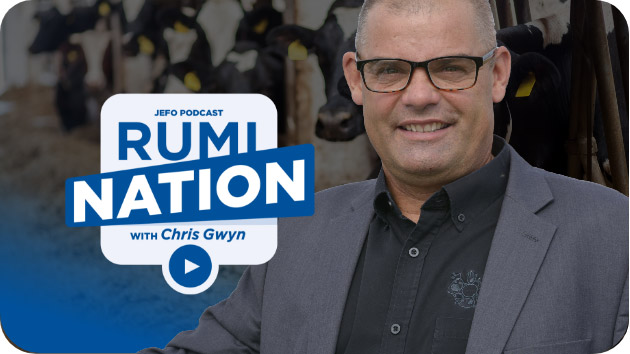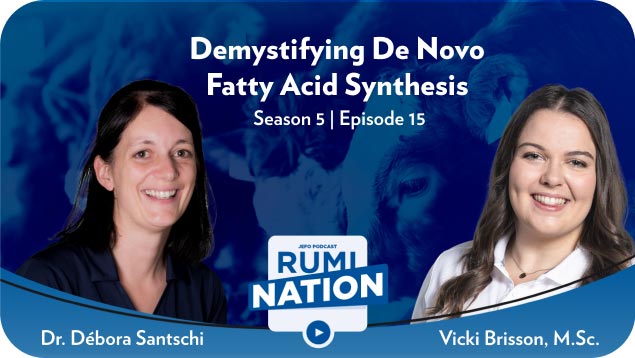RumiNation | S05 : E14
Cow-Calf Separation in Dairy Farming
Brought to you by Jefo Nutrition
Share now!
Did you enjoy this episode?
Share now!
Our guest - Dr. Marina Von Keyserlingk
Marina (Nina) Von Keyserlingk is a Professor at The University of British Columbia where she co-directs the Animal Welfare Program. Together with her colleagues and students, their research focuses on assessing animal welfare and developing practical methods of improving the welfare of animals. She has published hundreds of scientific papers and is a frequent and enthusiastic speaker for academic and professional audiences.

Timestamps & Summary
Chris Gwyn (01:57)
Animal welfare and perhaps its impacts on health are hot topics in the livestock industry today. Can you please share how you became interested in these topics?
Dr. Marina Von Keyserlingk
That started probably in my head, let’s say 25 years ago. As you alluded to in the introduction, I did a Ph.D. in Animal Sciences and I was trained initially as an experimentalist and as a ruminant nutritionist. And I worked in the feed industry in a number of roles for over seven years. And during my time, sort of at the end of my PhD, and also working in industry and coming from a farming background, what I was noticing and what was becoming very evident to me is that society was asking a lot of questions about where their food comes from. We had passed the time when society in general just trusted farmers to do the right thing. […]
It wasn’t necessarily that people wanted to become vegetarian. It was they just wanted assurances that animals had a reasonably good life. […]
Chris Gwyn (06:02)
Talk to me about how we maximize the amount of time that cow and calf spend together if that’s what we’re trying to do, and also to be realistic about the management procedures that a producer can or will implement at the farm level.
Dr. Marina Von Keyserlingk
I’m going to start a little bit further back than just that question. Why are we even talking about cow-calf separation? And ten years ago, I remember trying to apply for some money from the dairy industry and was basically told: Go away. […]
Generally speaking, what’s happening is that society is starting to ask questions. And society’s question is, when people see dairy, do they see a situation or do they hear about the fact that the calf is taken away? We provide assurances that the calf is going to be fine and the cow is going to be fine. […]
When we weigh all of the evidence on the health side and also on sort of the welfare behavior production side, I can’t give you strong evidence to justify the separation. So, for instance, calf health, we say we do this because it’s better for the calves. But what is the mortality rate of dairy calves in North America? We applaud when we can get it lower than sort of 6 or 7%. The beef industry would go broke if they had mortality rates at that. So, there are a lot of examples like that. Mastitis rates. Keeping cows and calves together is highly protective for mastitis. What’s one of the biggest economic costs for farmers is mastitis. So, we have this situation where we don’t have a lot of scientific evidence to justify the practice, but what we do have is 100 years of tradition. […]
It’s not a question of if it will become part of the conversation in North America. It’s just a matter of when. So, you know, there’s a farmer in southern Ontario that is keeping cows and calves together. I’ve talked to veterinarians in Quebec who are working with farmers that are trying to do this. Is it all working really well? Some things work well, some things are a disaster. […]
Chris Gwyn (15:03)
Do you have any hints of what can successfully work on a dairy?
Dr. Marina Von Keyserlingk
A lot of it is anecdotal. I would say the questions are actually a lot more fundamental than that. Like for instance, how long? Nobody really knows. […]
The only thing we know is from the beef industry, where we keep them together for six, seven or eight months, which is closer to when they wouldn’t wean naturally. I had to pick a number. We picked four months. Is four months right? I don’t know. […]
Chris Gwyn (19:04)
We don’t really know what the system really looks like, right? We’re talking about contact. As you say, it could be a full day, half day, it could be a partial day, it could be through a window, could be in the same pen. I mean, this is all the stuff that we don’t know and probably the stuff that maybe scares us a bit in production.
Dr. Marina Von Keyserlingk
Exactly right. And it scares us because at least here in North America, let’s just take Canada, for instance. We still have whatever 70% of our farms are, tie-stalls. How would this ever work in a tie-stall? I mean, we are transitioning out of that. I would not invest in cow-calf contact work in a tie-stall facility right now. […]
Change is scary. But change also brings opportunity. […]
I understand how difficult it is for farmers because change is really hard and it’s super scary, especially in those markets where they don’t have supply management. […]
Chris Gwyn (23:05)
What are the deep holes and research that are needed over the next five to ten years to help the dairy industry understand and find practical solutions for that cow requirement?
Dr. Marina Von Keyserlingk
I think it’s an exciting time in that area because it’s almost a blank slate. I think, as I said earlier, I think issues are going to be: How long? What does contact mean?
Chris Gwyn (28:30)
Tell me about some of the take-home messages you’d like to leave talking about cow-calf contact and what needs to be considered moving forward.
Dr. Marina Von Keyserlingk
The number one message is: Don’t be afraid of the conversation. […]
I think what the dairy industry needs to do is figure out how to keep the consumer because there are a ton of alternatives out there. We want the consumer to want to buy milk, to buy yogurt. And a lot of that comes down to values. […]
My other take-home message, just one other one, is I truly believe that the thoughtful person on the street doesn’t expect us to change overnight, but they expect us to get better every day. And those are two very different things.







